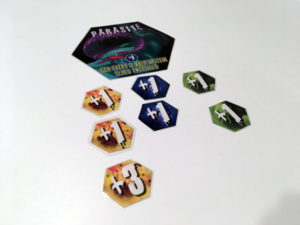Note: This preview uses pre-release components and rules. What you see here may be different from the final, published game. This post was a paid preview, you can find out more information here.
 Anyone who has studied biology, anatomy, and/or medicine can tell you that biological systems are a perfect subject matter for good board games. They are complex systems at work, upkeep that needs to happen, and combat in spades when it comes to fighting off infections.
Anyone who has studied biology, anatomy, and/or medicine can tell you that biological systems are a perfect subject matter for good board games. They are complex systems at work, upkeep that needs to happen, and combat in spades when it comes to fighting off infections.
One would think that there would be many games covering the topic. Answering the call to this relatively empty gaming domain is Andrew Gaia. Having sharpened some game design street-cred as one of the artists on Mystic Vale, this first time designer offers a new game with human biological systems as the battlefield.
Bio-Logic is a tile-laying, area-control game for 2-6 players that plays in about 60 minutes. It plays best with more than 2 players.
Game Overview:
Players in Bio-Logic are one of six foreign bodies invading a human: Amoeba, Virus, Parasite, Bacteria, Prion or ASP (Autonomous Strike Personnel – nanobots). Whose body it is doesn’t really matter. What does matter is that the player who improves the strength, resilience, and infection power of their invader enough will be able to survive a final battle against other invaders. The player whose infector wins the battle, wins the game.
How to Play:

Game turns begin with players using their “Super Bug” pawns to invade hex tiles. Based on the hex tile, players gain added strength to their abilities: Virulence (attack), Resistance (defense), or Cell Count (health/energy). Players can also gain other special powers as denoted by tokens with the appropriate letters. Some tiles can be automatically infected. If the tile is owned by another player or the human host, a combat occurs.
Combat for a hex tile is conducted with a series of dice rolls. The invader’s attack stat is compared to the defender’s defense stat, each modified with a die roll. If the invader fails, the defender gets a counterattack. Usually attacking is necessary to gain control of certain colors of tiles, which is necessary in order to move on to conquer other hex tiles.
Player turns will also reveal new tiles which represent different areas of the body. Revealing some of these tiles has a cost. This is paid for by using a player’s cell count stat. Exploring new tiles reveals additional areas of the body which become more and more resistant to infection but also yield bigger and bigger stat bonus rewards.
When the final areas (heart, brain, etc) of the body are successfully infected, the remaining invaders fight a battle to determine the victor. This is done in a ladder style battle where the lowest strength player fights the next higher strength player and so on.

Game Experience:
The first thing that comes to mind when looking at Bio-Logic are the carefully detailed illustrations lavished on all components. While these are well done and interesting, the overall effect is that there’s a huge buffet of imagery for the eye to focus on. Using more generic iconography for some components would make for an overall cleaner look and the main illustrations would stand out more.

A second area that left something to be desired was the movement system. The lack of this system, rather, makes for a seemingly low strategy game that depends greatly on what tiles various players draw. If a player manages to get lucky with an ability boost tile, they’re already one cell up on their opponents.
Where Bio-Logic really stands out is the fast, tile-laying, take-that gameplay. Some of the more advanced tiles have effects which punish adjacent players. Getting to these tiles quickly will slow the opposition and save a player’s stats for the final battle. Couple this with the lower level of strategy and it’s easy to see that Bio-Logic rewards aggression. Players who are overly sensitive to getting attacked may want to sit this one out.
Overall, the theme and the way location tiles are illustrated with various areas of the body also yields some non-standard table talk. As this is clearly more of a beer-and-pretzels-and-liver-and-colon game, Bio-Logic’s tile effects provide interesting moments to joke around ad nauseam with body part humor.
Final Thoughts:

Bio-Logic is a title unlike many other games. It’s a lighter game. The opportunities for a fun gaming experience are there, but it’s not for players looking for a heavy engine-building strategy game. Bio-Logic is a fun romp through the bloodstream, especially for after hours med students. It’s easy to bring out with fans of the subject matter or anyone who enjoys the aggressive conflict of everyday organisms.
Bio-Logic is currently in funding on Kickstarter, with pledges starting at $59 and delivery scheduled for November of 2017. If you’d like to become a backer, you can head over to the campaign page for more information.
As always, we don’t post ratings for preview copies as the components and rules may change from the final game. Check back with us after the game is produced for a full review. This post was a paid preview, you can find out more information here.






















